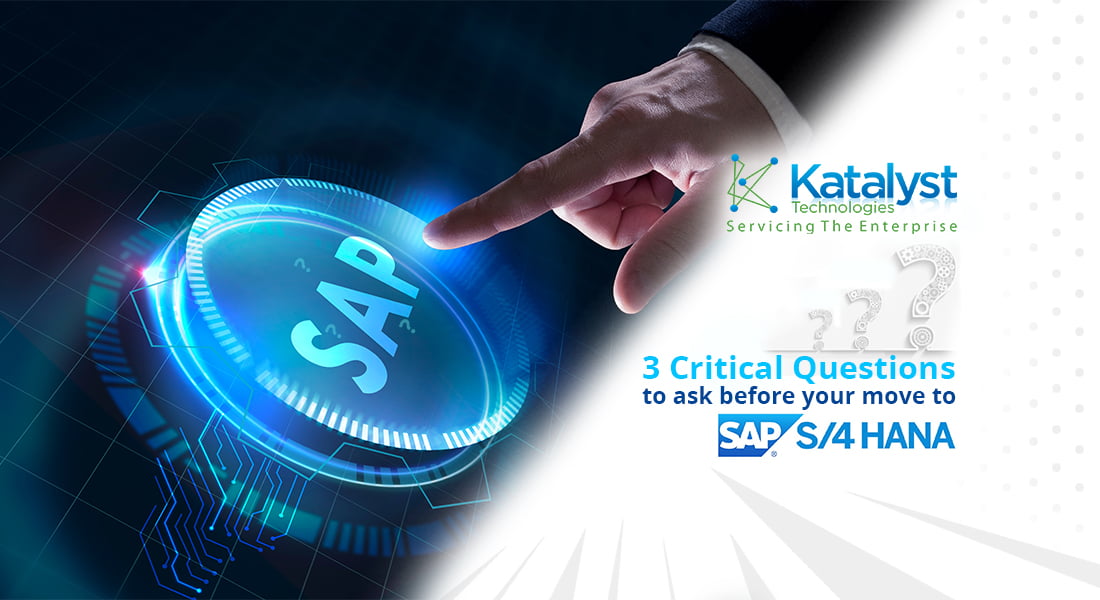
1. The “Why Now” question?
According to a recent article published by SAPinsider, the primary driver for businesses moving to SAP S4HANA is no longer the end of maintenance of their existing ERP systems — it is the business advantages offered by new and updated features included in the next-gen software.
Costs no longer were the key factor customers in deciding to move to SAP S/4 HANA. Instead, 61% of those building a business case prioritized understanding how SAP S/4HANA will affect specific business processes and key performance indicators (KPIs). This again shows a shift toward a more business-oriented approach to SAP S4HANA adoption.
The research points toward a shift in why and how enterprises approach their transition to SAP S/4HANA. The primary driver is no longer the end of maintenance of their existing ERP systems, but rather the business advantage offered by the new and updated features included with SAP S/4HANA. The research also connects many organizations’ plans for SAP S/4HANA to the digital transformation policies they are currently pursuing.
It is imperative that the move to SAP S/4 HANA not be treated as an IT upgrade project. It is critical that all the key stakeholders are aligned on the need for a change. The underlying factors driving the need for change be called out in the vision. Alignment on the need for change builds buy-in across stakeholders and forms the basis of a strong business case.
2. The “What” questions?
Once you have clarity of the “Why Now” question, it is important to dig deeper and answer the “What” set of questions. What needs to be done to achieve the defined vision? This will help distill and further build your business case.
Do key processes need to be modernized or simplified?
Process simplification, along with process modernization, are the two crucial lenses to keep in mind.
Process Simplification: Current processes will most likely be a carryover from the initial SAP implementation years ago – do these processes need to be improved/reviewed? Is a complete re-design across the board required?
Process Modernization: SAP S4HANA and the SAP Cloud Platform provide a framework for innovation and modernizing your critical processes. Focus on the value a process re-design and modernization will bring in. Areas to focus on could include SAP Finance automation using RPA (Robotic Process Automation), AI/ML-based ChatBots for customer service, and other functional areas.
Has your SAP solution architecture become too complex to manage? Is it in line with the long-term SAP product direction?
SAP solution architecture and solution components are an essential aspect to understand given the latest SAP product direction; for example, would some processes be a better fit outside the core, like HR or Sourcing?
Do you have multiple SAP instances? Is this the right time to consolidate or do you need a 2-tier ERP strategy?
SAP Instance strategy is a critical decision in ensuring a standardized core across the enterprise, with a single data model. This must be balanced with the business units’ diverse requirements, geographical spread, legal and statutory requirements.
Are you leveraging the cloud to manage your SAP workloads?
Many SAP customers have already migrated or are considering moving their SAP workload to the cloud. Public/Private/Hybrid cloud decisions will have to be made in alignment with the overall enterprise strategy. It may also be the right time to examine the benefits of hyperscalers like AWS, Azure, and GCP, beyond the obvious benefits of cloud economics. Other factors to consider are hardware/software end of life, data center consolidation, security and operational resilience, and the adoption of new technologies (AI/ML, IoT, Big Data) across the enterprise.
Be clear on what you are trying to achieve – the Total cost of ownership and business case is largely dependent on clearly identifying and answering these questions.
3. The “How” question?
There are multiple considerations to factor while answering the “How” question.
- Brownfield/Greenfield/Hybrid: Answering the “What” questions above will guide you in making the Brownfield, Greenfield, or hybrid decision. While there are pros/cons for each approach, the right fit will depend on “what are you looking to achieve?”
- Architecture: Beyond the SAP solution components, it is important to have an enterprise view of your application, IT infrastructure, and security strategy. Plan to leverage an Enterprise Architect as part of your team to define the To-Be enterprise architecture.
- Pre-configured solutions: Pre-configured solutions like SAP Model company / Qualified Partner packages, especially in a Greenfield scenario, can play an essential role in time-to-market and should be closely examined.
- Early Work: As with any SAP project, early work activities will help with a smoother implementation. There are three critical early work elements to consider,
- Data: Fix outstanding data issues before you embark on the project; evaluate data archiving requirements and your current data management/maintenance strategy.
- Process Simplification: As noted above, early identification of processes causing chokepoints to smooth execution at the current scale of operations is critical and will form the basis for multiple downstream project decisions.
- Custom Code: Identify enhancements, reports, and unused custom code that are redundant and not required moving forward.
Other considerations:
Team Mindset: As you build your internal team and get them up-to-speed on SAP S4HANA, it is vital to have team members who will ‘adapt’ to the new way of doing things and avoid the ‘this will not work for us’ trap.
Change Management: SAP S/4 HANA can bring about significant changes to specific processes, e.g., RPA for finance processes. Focus on Change management will ensure that the change is correctly managed and the faster adoption of the ‘new ways of working correctly’.
Use of Agile/Activate Project Management: Plan to have an Agile coach with experience in distributed Agile methodology to manage your work packages across remote teams.
In conclusion, the move to SAP S4HANA provides the platform to future proof your organization by modernizing the enterprise core and moving to a new flexible architecture model.

